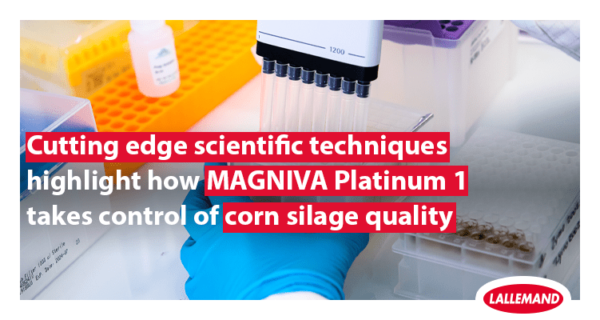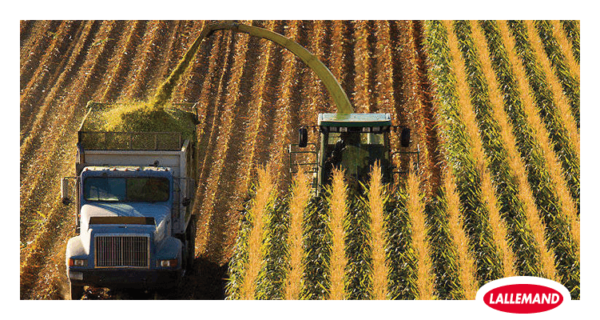Blog | Reading Time 5 minutes
Management and expectations of corn silage this coming season
The 22/23 corn silage season is shaping up to be a challenging year, due to excessive spring rain and flooding in some areas – resulting in heavy, saturated soils. The cool, wet spring has delayed planting and resulting in a late harvest for some areas. Silage makers may have to make tough decisions on the best time to ensile their forages in 2023.
It is vital to keep in mind the challenging growing and harvesting conditions experienced when the silage stacks are opened at feed out. It will help producers manage expectations of the corn silage and correctly balance rations accordingly, allowing for the best performance possible for their livestock.
Late corn planting
Delayed corn planting and irregular growing conditions can cause variations within crop, maturity, plant quality in the field and expected yields, which are typically reduced. Potentially the corn silage will have less grain and, consequently, lower starch (energy) content.
The initial question from delayed planting is: Would there be enough growing degree days for the plant to reach desired maturity? The late planting and lower temperatures experienced in some areas could extend the usual days needed from silking to silage harvest maturity. Additionally, the time of harvest will be later, which could result in harvesting in wet fields if rain comes early, immature corn and/or frost- damaged corn.
Weather effects during harvest
The risk of wet conditions when accessing the field at harvest present difficult operating conditions, additional expense, and often extended harvest times.
Soil contamination in the silage, is often evident, coming from many different sources during harvest, such as on tires from the field, dirt pads for the storage area and more. This results in higher than usual ash values shown on the feed analysis. Corn plants have internal ash levels of about 4% dry matter (DM), and each extra percentage point represents 10 kilograms of soil contamination per tonne of corn silage.
As well as increasing the ash level, soil also harbors undesirable microorganisms such as clostridia, fungi and enterobacteria, which can negatively impact the silage fermentation. For this type of scenario, a proven, effective heterolactic forage inoculant should be used to minimize activity of the unwanted microbes and to efficiently drive fermentation – saving nutrients and reducing shrink.
Corn harvest
The recommended dry matter (DM) for whole-plant corn for silage ranges from 32 to 38% DM (62% to 68% moisture). Early harvests, with DM levels lower than 30%DM (higher than 70% moisture), can lead to increased effluent seepage and a prolonged fermentation. This can result in a high acid load that may depress feed intake. Clostridial growth is rarely an issue in corn silage, even if wet, but the extra moisture may stimulate microbial activity in general. These silages typically have a low ratio of lactic- to-acetic acids and a higher degree of protein breakdown expressed as soluble protein and ammonia-N. In turn greater levels of other fermentation products, such as alcohols and esters, some of which may have a negative impact on intake and performance.
In addition, seepage loss during ensiling results in the loss of soluble, digestible nutrients (sugars, soluble-N and soluble minerals).
These immature plants will have greater sugar content and lower starch levels because the plant sugars did not have the time to be converted into starch. In addition, producers can expect higher fibre and crude protein contents. Thus, the energy value of immature corn silage will be 85% to 90% of regular corn silage
If harvesting extremely immature corn before the reproductive growth of the plant has started, it’s treated like a grass forage. Corn plants are mowed during the vegetative phase, wilted, and ensiled.
Corn harvested after frost
Frost can have varying impacts on a corn plant. If a severe frost has killed the plant, it can lose moisture rapidly. Harvest timing is then based on whole plant DM to avoid ensiling too dry. If silage is dry, ensure to check particle size and packing density to ensure good compaction. Trapped air will encourage plant respiration, moulding and heating. This delays fermentation and results in significant DM and digestible nutrient (sugars and true protein) losses.
A quick frost should not be too detrimental; although the plants appear dry, there is still plenty of moisture in the stalks. If the portion of the plant above the cob is alive (green colour compared to brown) after a frost, it will advance in maturity, and the kernels will still accumulate starch from soluble sugars.
Additionally, frosted kernels and other parts of the plant are susceptible to fungal infestation and could possibly lead to production of mycotoxins. This situation again calls for a proven, effective microbial inoculant to ensure a good ensiling fermentation.
Mature corn will have a high starch content, but it will have lower digestibility due to starches being imbedded in a prolamin-protein matrix. The rate and extent of starch digestibility in the corn silage is influenced by hybrid type (e.g., floury vs vitreous kernel varieties), moisture content and storage time.
Nitrates may be a concern for frost-damaged plants. If feeding straight after ensiling – almost like a green chop – be careful with the nitrate risk at feeding. A nitrate test is highly recommended prior to feeding. The fermentation process reduces the nitrate level in the silage by 40% to 50%. To ensure worker safety, be aware of the increased risk of toxic nitrogen dioxide gas during feed out – especially any orange fumes.
Sampling and analysing corn silage
Considering all the challenges during a growing and harvest season, sending representative samples to a forage testing laboratory for nutrient and fermentative profiles is a good investment, especially if the corn plants in the silage came from different fields. Representative samples should be taken, being careful to minimise microbial activity during handling and shipping. Freeze samples and ship express post.
Published Dec 1, 2022



